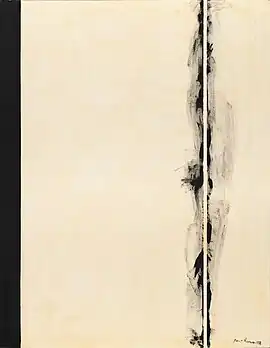The Stations of the Cross (Newman)
The Stations of the Cross / Lema Sabachthani is a series of fifteen abstract expressionist paintings created between 1958 and 1966 by Barnett Newman, often considered to be his greatest work.[1] It consists of fourteen paintings, each named after one of Jesus's fourteen Stations, followed by a coda, Be II. Unlike most depictions of the Stations of the Cross, Newman did not intend for this to be a narrative journey of Jesus's suffering. Rather, it was intended to evoke the central question of the Passion, lema sabachthani (why have you forsaken me?).[2] The secular, Jewish Newman used this central theme of Christian theology to probe the human condition rather than towards its historical purpose of devotion or worship.[3]
| First Station | |
|---|---|
 | |
| Artist | Barnett Newman |
| Year | 1958 |
| Medium | Magna on canvas |
| Dimensions | 197.8 cm × 153.7 cm (77 7/8 in × 60 1/2 in) |
| Location | National Gallery of Art, Washington, D.C. |
| Fourteenth Station | |
|---|---|
 | |
| Artist | Barnett Newman |
| Year | 1965/1966 |
| Medium | Acrylic and Duco on canvas |
| Dimensions | 198.1 cm × 152.2 cm (78 in × 59 15/16 in) |
| Location | National Gallery of Art, Washington, D.C. |
The series has been seen as a memorial to the victims of the Holocaust.[4]
References
- "Barnett Newman's Masterpiece "Stations of the Cross" is Focus of Fifth "In the Tower" Exhibition at National Gallery of Art, June 10, 2012–February 24, 2013". www.nga.gov. Retrieved 2023-07-16.
- Kennicott, Philip (2023-05-24). "Barnett Newman's 'Stations of the Cross' draws pilgrims to the National Gallery". Washington Post. ISSN 0190-8286. Retrieved 2023-07-16.
- Floyd, Emily (2013-05-24). "Barnett Newman, The Stations of the Cross: Lema Sabachtani". mavcor.yale.edu. Retrieved 2023-07-16.
- Menachem Wecker (August 1, 2012). "His Cross To Bear. Barnett Newman Dealt With Suffering in 'Zips'". The Jewish Daily Forward. Retrieved August 8, 2012.